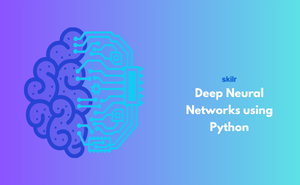👇 CELEBRATE CLOUD SECURITY DAY 👇
00
HOURS
00
MINUTES
00
SECONDS

Deep Neural Networks with Python focus on creating computer programs that can learn on their own by analyzing large amounts of data. Instead of being manually programmed for every task, these networks use multiple hidden layers to process information and improve performance with each step. Python, being simple and flexible, provides a rich ecosystem of tools to design, train, and test these advanced AI systems.
Essentially, this field is about teaching machines to handle challenges like understanding speech, detecting objects in images, or predicting trends. By mastering DNNs with Python, learners gain the ability to work on cutting-edge AI projects, making them highly valuable in industries driven by data and automation.
This exam is ideal for:
Domain 1 - Introduction to Deep Neural Networks
Domain 2 - Python for Deep Learning
Domain 3 - Neural Network Foundations
Domain 4 - Deep Learning Architectures
Domain 5 - Training and Optimization
Domain 6 - Working with Data
Domain 7 - Advanced Topics
Domain 8 - Practical Applications
Domain 9 - Model Deployment
Industry-endorsed certificates to strengthen your career profile.
Start learning immediately with digital materials, no delays.
Practice until you’re fully confident, at no additional charge.
Study anytime, anywhere, on laptop, tablet, or smartphone.
Courses and practice exams developed by qualified professionals.
Support available round the clock whenever you need help.
Easy-to-follow content with practice exams and assessments.
Join a global community of professionals advancing their skills.
Deep learning uses multi-layer neural networks to automatically extract features and patterns from data, while traditional machine learning requires manual feature engineering.
Yes, deep learning skills are highly sought after, and many companies are looking for experts to develop and deploy neural network models.
While some basic knowledge of machine learning and Python is helpful, it's not required to start learning deep neural networks.
It opens doors to high-demand positions in industries like healthcare, finance, autonomous driving, and tech, where deep learning plays a crucial role.
Roles such as AI Engineer, Machine Learning Engineer, Data Scientist, Research Scientist, and Deep Learning Specialist.
You’ll gain proficiency in building neural networks, model optimization, and evaluating performance for various applications, such as NLP and image processing.
Healthcare, autonomous vehicles, finance, e-commerce, robotics, and entertainment rely on deep learning for tasks like image recognition and predictive analytics.
Deep learning is at the forefront of AI technology, and mastering neural networks allows you to build sophisticated models for complex tasks.
Aspiring data scientists, machine learning engineers, software developers, and AI researchers interested in deep learning.
Yes, Python is the most popular language for deep learning due to its powerful libraries like TensorFlow and Keras, which simplify building neural networks.